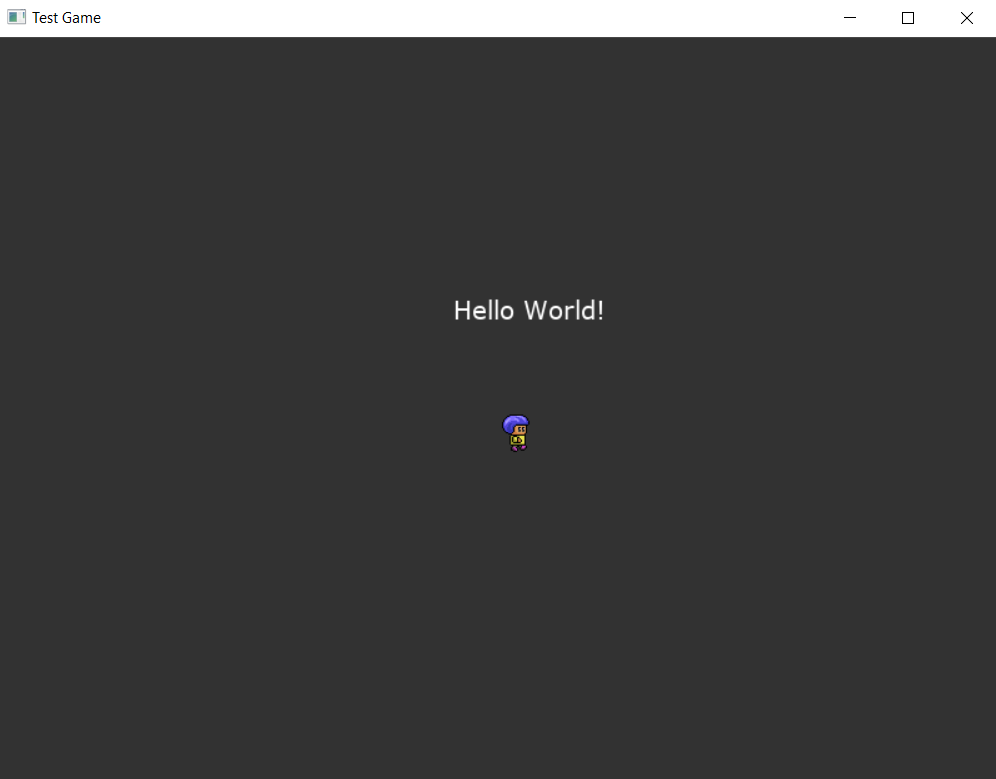Rendering Text
Font
Freetype Library
Red Engine uses the FreeType to help render font.
Font Class
Before we render text to the screen, we need to first define the concept of a font within Red Engine.
#pragma once
#include <iostream>
#include <string>
#include <map>
#include <ft2build.h>
#include FT_FREETYPE_H
#include <glad/glad.h>
#include "../math/math.h"
#include "../utils/file_helper.h"
#include "../utils/logger.h"
struct Character {
GLuint textureID;
Vector2 size;
Vector2 bearing;
unsigned int advance;
};
class Font {
public:
std::map<GLchar, Character> characters;
GLuint VAO;
GLuint VBO;
Font(FT_Library freeTypeLibrary, const char* fileName, int size) : filePath(std::string(fileName)), size(size) {
LoadFont(freeTypeLibrary, fileName, size);
ConfigureVertex();
}
std::string GetFilePath() const {
return filePath;
}
int GetSize() const {
return size;
}
bool IsValid() const {
return valid;
}
private:
std::string filePath;
int size;
bool valid = false;
void LoadFont(FT_Library freeTypeLibrary, const char* fileName, int size) {
static Logger *logger = Logger::GetInstance();
if(!FileHelper::DoesFileExist(fileName)) {
logger->Error("Font doesn't exist at path: %s", fileName);
}
FT_Face face;
if(FT_New_Face(freeTypeLibrary, fileName, 0, &face)) {
logger->Error("Freetype failed to load font!");
} else {
// set size to load glyphs. width set to 0 to dynamically adjust
FT_Set_Pixel_Sizes(face, 0, size);
// disable byte-alignment restriction
glPixelStorei(GL_UNPACK_ALIGNMENT, 1);
// load first 128 characters of ASCII set
for(unsigned char c = 0; c < 128; c++) {
// load character glyph
if(FT_Load_Char(face, c, FT_LOAD_RENDER)) {
logger->Error("Freetype Failed to load Glyph");
continue;
}
// generate texture
unsigned int textTexture;
glGenTextures(1, &textTexture);
glBindTexture(GL_TEXTURE_2D, textTexture);
glTexImage2D(
GL_TEXTURE_2D,
0,
GL_RED,
face->glyph->bitmap.width,
face->glyph->bitmap.rows,
0,
GL_RED,
GL_UNSIGNED_BYTE,
face->glyph->bitmap.buffer
);
// set texture options
glTexParameteri(GL_TEXTURE_2D, GL_TEXTURE_WRAP_S, GL_CLAMP_TO_EDGE);
glTexParameteri(GL_TEXTURE_2D, GL_TEXTURE_WRAP_T, GL_CLAMP_TO_EDGE);
glTexParameteri(GL_TEXTURE_2D, GL_TEXTURE_MIN_FILTER, GL_LINEAR);
glTexParameteri(GL_TEXTURE_2D, GL_TEXTURE_MAG_FILTER, GL_LINEAR);
// store character for later use
Character character = {
.textureID = textTexture,
.size = Vector2(face->glyph->bitmap.width, face->glyph->bitmap.rows),
.bearing = Vector2(face->glyph->bitmap_left, face->glyph->bitmap_top),
.advance = static_cast<unsigned int>(face->glyph->advance.x)
};
characters.insert(std::pair<char, Character>(c, character));
}
glBindTexture(GL_TEXTURE_2D, 0);
valid = true;
}
FT_Done_Face(face);
}
void ConfigureVertex() {
// configure VAO & VBO texture quads
glGenVertexArrays(1, &VAO);
glGenBuffers(1, &VBO);
glBindVertexArray(VAO);
glBindBuffer(GL_ARRAY_BUFFER, VBO);
glBufferData(GL_ARRAY_BUFFER, sizeof(GLfloat) * 6 * 4, NULL, GL_DYNAMIC_DRAW);
glEnableVertexAttribArray(0);
glVertexAttribPointer(0, 4, GL_FLOAT, GL_FALSE, 4 * sizeof(GLfloat), nullptr);
glBindBuffer(GL_ARRAY_BUFFER, 0);
glBindVertexArray(0);
}
};
Update Rendering
Renderer Batcher
Adding FontBatchItem struct. Also adding vector for font draw batches.
struct FontBatchItem {
Font *font = nullptr;
std::string text;
float x = 0.0f;
float y = 0.0f;
float scale = 1.0f;
Color color = Color(1.0f, 1.0f, 1.0f, 1.0f);
};
struct ZIndexDrawBatch {
std::vector<SpriteBatchItem> spriteDrawBatches;
std::vector<FontBatchItem> fontDrawBatches;
};
Adding function to batch draw font.
void RendererBatcher::BatchDrawFont(FontBatchItem fontBatchItem, int zIndex) {
if (drawBatches.find(zIndex) == drawBatches.end()) {
drawBatches.emplace(zIndex, ZIndexDrawBatch{});
}
drawBatches[zIndex].fontDrawBatches.emplace_back(fontBatchItem);
}
Renderer2D
Function to submit font draw batch item.
void Renderer2D::SubmitFontBatchItem(Font *font, const std::string &text, float x, float y, int zIndex,
float scale, Color color) {
FontBatchItem fontBatchItem = {
font,
text,
x,
y,
scale,
color
};
rendererBatcher.BatchDrawFont(fontBatchItem, zIndex);
}
Next is to update the FlushBatches function to draw font.
void Renderer2D::FlushBatches() {
assert(spriteRenderer != nullptr && "SpriteRenderer is NULL, initialize the Renderer2D before using!");
const RenderFlushFunction &renderFlushFunction = [this] (const int zIndex, const ZIndexDrawBatch &zIndexDrawBatch) {
// Draw Sprites
for (const SpriteBatchItem &spriteBatchItem : zIndexDrawBatch.spriteDrawBatches) {
spriteRenderer->Draw(spriteBatchItem.texture2D,
spriteBatchItem.sourceRectangle,
spriteBatchItem.destinationRectangle,
spriteBatchItem.rotation,
spriteBatchItem.color,
spriteBatchItem.flipX,
spriteBatchItem.flipY);
}
// Draw Font
for (const FontBatchItem &fontBatchItem : zIndexDrawBatch.fontDrawBatches) {
fontRenderer->Draw(fontBatchItem.font,
fontBatchItem.text,
fontBatchItem.x,
fontBatchItem.y,
fontBatchItem.scale,
fontBatchItem.color);
}
};
rendererBatcher.Flush(renderFlushFunction);
}
Render Context
We then add this to the render context to initialize the FreeType library.
FT_Library freeTypeLibrary;
void InitializeFont() {
if(FT_Init_FreeType(&freeTypeLibrary)) {
Logger::GetInstance()->Error("Could not initialize FreeType Library!");
}
}
Asset Manager
Be sure to add RenderContext to AssetManager.
AssetManager::AssetManager() : logger(Logger::GetInstance()), renderContext(RenderContext::GetInstance()) {}
Also add functions for fonts.
void AssetManager::LoadFont(const std::string &fontId, const std::string &fontPath, int size) {
Font *font = new Font(fontId, renderContext->freeTypeLibrary, fontPath.c_str(), size);
fonts.emplace(fontId, font);
}
Font* AssetManager::GetFont(const std::string &fontId) {
assert(fonts.count(fontId) > 0 && "Font hasn't been loaded!");
return fonts[fontId];
}
bool AssetManager::HasFont(const std::string &fontId) const {
return fonts.count(fontId) > 0;
}
Render Text
In InitializeRendering we are adding:
renderContext->InitializeFont();
We will also load a font into asset manager with:
assetManager->LoadFont("assets/fonts/verdana.ttf", "assets/fonts/verdana.ttf", 20);
Next to render text, we call this within our Render function:
static Font *textFont = assetManager->GetFont("assets/fonts/verdana.ttf");
static const std::string &text = "Hello World!";
static Vector2 fontPosition = Vector2(windowCenter.x - 35.0f, windowCenter.y - 20.0f);
static Color fontColor = Color(1.0f, 1.0f, 1.0f);
renderer2D.SubmitFontBatchItem(textFont, text, fontPosition.x, fontPosition.y, 0, 1.0f, fontColor);
Once we run the engine, the following will be rendered to the screen:
We have finally rendered text to the screen! All source code for this section can be found here. Now that we have a way to render sprites and text to the screen it's now time to start adding implementing audio to play music and sound effects!
